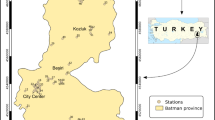Abstract
The article has determined pollution levels of the waters of the Kiev Reservoir by indices of radiation safety (total beta activity and total alpha activity). It has been found that the change of these indices is of a seasonal nature: maximum values are observed in April, minimal—in February. The paper has analyzed the possibility of using the Kiev Reservoir as a source of drinking and irrigation water according to effective hygienic and ecological standards.
Similar content being viewed by others
References
Denisova, A.I., Timchenko, V.M., Nakhshina, E.P., et al., Gidrologiya i gidrokhimiya Dnepra i ego vodokhranilishch (Hydrology and Hydrochemistry of the Dnieper River and Its Reservoirs), Kiev: Nauk. Dumka, 1989.
Ekologicheskie posledstviya avarii na Chernobyl’skoi AES and ikh preodolenie: dvadtsailetnii opyt. Doklad ekspertnoi grupy “Ekologiya” Chernobyl’dkogo foruma (Ecological Aftermath of Chernobyl NPP Disaster and Its Overcoming: Twenty Years of Experience. Report of the Ecology Expert Group of the Chernobyl Forum, Vienna, IAEA, 2008.
Bol’shaya Sovetskya Entsiklopediya (Great Soviet Encyclopedia), Moscow: Sovetskaya Entsiklopaedia, 1969–1978.
Grezer, V.N., Polikarpov, G.G., Romanenko, V.D., et al., Priroda Ukrainskoi SSR. Morya i vnutrennie vody (Nature of the Ukrainian SSR. Seas and Internal Waters), Kiev: Nauk Dumka, 1987.
Dvadtsyat’ pyat’ rokiv Chornobyl’skoi katastrofy: Bezpeka maibutn’ogo, Nats. Dopovid’ Ukrainy (Twenty Five Years of Chornobyl Disaster: Safety of the Future. National Report of Ukraine, Kiev: KIM. 2011.
Natsional’na dopovid’ pro stan tekhnogenoi ta prirodnoi bezpeki v Ukraini u 2010 r. (National Report about the State of Technogenic and Natural Safety in Ukraine in 2010), Kiev: MNS Ukrainy, 2011.
Natsional’na dopovid’ pro stan tekhnogenoi ta prirodnoi bezpeki v Ukraini u 2011 r. (National Report about the State of Technogenic and Natural Safety in Ukraine in 2011), Kiev: MNS Ukrainy, 2012.
Vishnevskii, V.I. Rika Dnipro (The River Dnieper), Kiev: Interpress, Ltd., 2012.
Kompeksnyi atlas Kyivs’koi oblasti (Comprehensive Atlas of Kiev Region), Kiev: Kartografia, 2009.
Voitsekhovych, O.V., Chronobyl’ska avaria i upravlinnya radioktyvnymym zabrudnennyam vod v Ukraini. 20 rokiv Chornobyl’skoi katastrofy. Poglyad u maibutne: Nats. Dopovid’ Ukrainy (Chornobyl Disaster and Management of Radioactive Pollution of Waters in Ukraine: Look into the Future, National Report of Ukraine), Kiev: Atika, 2006.
Tekhnogenni radionuklidy u prisnovodnykh ekosystemakh (Technogenic Radinuclides in Fresh-Water Ecosystems), Romanenko, V.D., Kiev: Nauk. Dumka, 2010.
Giriy, V.A., Zakorchevnyi, V.O., Kosovets’, O.O., and Lebo, Yu.G., Nauk. PratsiNDGMI, 2003, issue 252, pp. 123–130.
Yakimenko, G.M., Agrekol. Zhurn., 2012, no. 1, pp. 85–88.
Kuchma, M.D. and Yakimenko, G.M., Materialy 5 Vseukr. Nauch-Prakt. Chervnya 2011 r.), Yaremche, 2011.
GN 6.6.1.1-130-2006. Dopustymi rivni vmistu radionuclidiv tseziu-137 nastrontsiu-90 u produktakh kharchuvanna ta pytnii void (Accessible Levels of the Content of Radionuclides of Cesium-137 and Strontium-90 in Food Staffs and Drinking Water), introduced on May 3, 2000.
DSTU 4808:2007. Dzherela tsentralozovanogo pytnogo vodopostachannya. Gigienichni na ekologichni vymogy shchodo yakosti vody i pravyla vidbyrannya (Sources of Centralized Drinking Water Supply. Hygienic and Ecological Requirements to Water Quality and Sampling Rules), introduced on January 1, 2011.
DSanPin 2.2.4-171-10. Gigenichni vymogy do vody pytnoi pryznachenoi dlya spozhyvannya lyudynoyu (DSanPin 2.2.4-171-1to Drinking Water Designed for Human Consumption), introduced on May 12, 2010.
Vodna ramkova dyrektyva 2000/60 EU. Osnovni terminy ta ikh vyznachennya (Water Frame Directive. Main Terms and Their Definitions), Kiev: Official Translation of the State Department of the Questions on Adaptation of Legislation, Ministry of Justice of Ukraine, 2006.
Direktiva 98/83/EU. Stosovno yakosti vody, priznachenoi dla spozhyvannya lyudynoyu. (Directive 98/83/EU. Concerning Water Quality Designed for Human Consumption), introduced on Oct. 23, 2010.
DSTU ISO 5667-4-2003. Yakist’ vody. Vidbyrannay prob. P. 4. Nastanovy shcjodo vidbyrannya pro biz prirodnykh ta shtuchnykh ozer (DSTU ISO 5667-4-2003. Water Quality. Taking Samples. P. 4. Directives on Sampling from Natural and Artificial Lakes), introduced on July 1, 2004.
Nastanova hidrometeorolognym snantsiyam i postam. Vyp. 12, p. 2. Sposterezhennya za radioaktyvnym zabrudnennya povernevykh vod sushi i mors’kykh vod (Instruction to Hydrometeorological Stations and Posts. Issue 12, p. 2. Observations over Radioactive Pollution of Surface Waters of Land and Sea Waters, Kiev: Derzhgidromet Ukrainy, 2010.
Metod. Rekomendatsii. Podgotovka prob prirodnykh vod dlya izmereniya summarnoi al’fa- and beta-aktivnosti (Method. Recommendations. Preparation of Samples of Natural Waters for Measuring Total Alpha and Beta Activities), Moscow: NPP Doza, 1997.
DSTU ISO 9696-2001. Zakhist vid radiatsii. Vymiryuvannya alpha-aktvity u prisnii vodi. Metod kontsentrovanogo dzherela (Protection against Radiation. Measuring Alpha Activity in Fresh Water. Method of Concentrated Source), introduced on July 1, 2003.
ISO 9696:2007. Water Quality. Measurement of Gross Alpha Activity in Non-Saline Water. Thick Source Method, published November 15, 2007.
MVV No. 081/12-0078-03. Metodyka vykonannya pytomoi beta-aktyvnosti pytnoi vody ta vod dzherel vodopostachannya (MVV No. 081/12-0078-03. Technique of Measuring Specific Beta Activity of Drinking Water and Water of Water-Supply Sources), Kiev. 2003.
Metodika otsenki ekologicheskogo usherba nanesenogo respublike Belarus’ radioaktivnymi zagryazneniem mineralno-syrievykh i vodnykh resursov (Technique of Assessing Ecological Damage Done to the Republic of Belarus” by Radioactive Pollution of Mineral-Feedstock and Water Resources), Minsk: 2000.
Vodnyi kodeks Ukrainy (Water Code of Ukraine) (wording of January 1, 2008), VVR, 1995, no. 24.
DSTU 2730-94. Sistema standartov u galuzi okhorony navkolishnogo prirodnogo seredovyshcha ta ratsional’nogo vykorystannya resursiv. Yakist’ prirodnoi vody dlya zroshennya. Agronomichni kryteri (DSTU 2730-94. The System of Standards in the Field of Protection of Ambient Natural Environment and Conservation of Resources. Quality of Natural Water for Irrigation. Agronomical Criteria, introduced on July 1, 1995.
VND33-5.5-02-97. Yakist’ vody dlya zroshennya. Ekologichnikryterii (VND33-5.5-02-97. Water Quality for Irrigation. Ecological Criteria), introduced on April 1, 1998.
Edyne mizhvidomche kerivnytstvo po orgnizasii na zdiisnennyu derzhavnogo monitoringu vod (Single Interdepartmental Management in Organization and Implementation of State Monitoring of Waters), endorsed by order no. 485, of December 24, 2001.
Author information
Authors and Affiliations
Additional information
Original Russian Text © A.N. Yakimenko, 2013, published in Khimiya i Tekhnologiya Vody, 2013, Vol. 35, No. 4, pp. 341–348.
About this article
Cite this article
Yakimenko, A.N. Estimation of water quality of the Kiev reservoir by indices of radiation safety. J. Water Chem. Technol. 35, 189–193 (2013). https://doi.org/10.3103/S1063455X13040085
Received:
Published:
Issue Date:
DOI: https://doi.org/10.3103/S1063455X13040085




